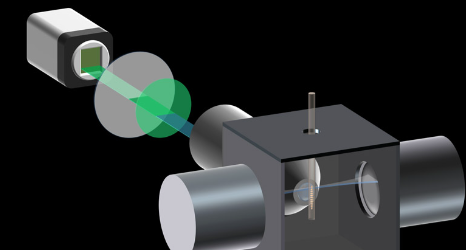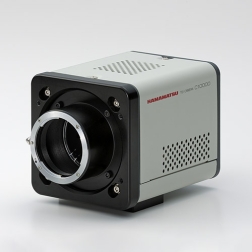The ORCA-Fusion, built from the sensor up, balances the complex nuances of camera features to provide beautiful images and robust data at all lights levels, but especially in tough low-light conditions. The exceptionally low and highly uniform read noise of the ORCA-Fusion means that when the sample emits even just a handful of photons, either by default or by experimental design, they are not lost in the noise, but detected and reliably quantified. After all, when you want to hear a whisper it’s best to be in a quiet place.
Features
- High resolution : 2304 x 2304 (5.3 Megapixels)
- High speed : 100 frames/s (at 2304 X 2048 ROI)
- Dynamic range : 21,400:1
- Pixel size : 6.5 μm X 6.5 μm
- Read noise : 0.7 electrons, rms (Ultra-quiet Scan)
- Prnu : 0.06 % rms (@ 7500 electrons)
- DSNU : 0.3 electrons rms
- Peak QE : 80 %
- Patented Tools for Advanced Imaging: Lightsheet Readout Mode
Lightsheet Readout Mode [Patented]
“Lightsheet Readout Mode” is a unique and patented feature of Hamamatsu sCMOS cameras which can improve signal to noise ratios in Lightsheet microscopy.
For more information about the principle and features of Lightsheet Readout Mode, please see details from below.
What is Lightsheet Readout Mode?

PC recommendations
With the introduction of the ORCA-Fusion, users are now able to stream 5 megapixel images to their computers 89 frames per second. The computer recommendations for this high data rate can be met by using the guidelines listed this PC Recommendations for ORCA-Fusion.
| Type number |
C14440-20UP |
| Quantum efficiency |
400 nm: 65 % *1
550 nm: 80 % *1
700 nm: 70 % *1
800 nm: 50 % *1 |
| Imaging device |
sCMOS |
| Effective no. of pixels |
2304(H)×2304(V) |
| Cell size |
6.5 μm(H)×6.5 μm(V) |
| Effective area |
14.976 mm (H)×14.976 mm (V) |
| Full well capacity |
15 000 electrons *1 |
| Readout speed |
Fast scan: 11.22 ms (89.1 frames/s with CoaXPress or 31.6 frames/s with USB 3.0) (2304 x 2304) *4
Standard scan: 42.99 ms (23.2 frames/s with CoaXPress or USB 3.0) (2304 x 2304) *4
Ultra-quiet scan: 184.4 ms (5.4 frames/s with CoaXPress or USB 3.0) (2304 x 2304) *4 |
| Readout noise |
Fast scan:1.4 electrons rms *1
Standard scan:1.0 electrons rms *1
Ultra-quiet scan:0.7 electrons rms *1 |
| Exposure time |
Fast scan: 17 μs to 10 s (4.87 μs step)
Standard scan: 65 μs to 10 s (18.65 μs step)
Ultra-quiet scan: 280 μs to 10 s (80.00 μs step) |
| Cooling method |
Peltier cooling |
| Cooling temperature |
Forced-air cooled: -5 ˚C (Ambient temperature: +25 ˚C)
Water cooled: -5 ˚C (Water temperature: +25 ˚C)
Water cooled (Max cooling): Less than -15 ˚C *1,*8 |
| Dark current |
Cooling temperature(-5 ˚C): 0.5 electrons/pixel/s *1,*3
Cooling temperature(-15 ˚C): 0.2 electrons/pixel/s *1,*3 |
| Dynamic range |
21 400 : 1 *1,*2 |
| External trigger mode |
Edge, Level, Sync readout, Start, Global reset edge, Global reset level |
| External trigger signal routing |
SMA |
| Trigger delay function |
0 s to 10 s in 1 μs steps |
| Trigger output |
Global exposure timing, trigger ready, low, high |
| External signal output routing |
SMA |
| Interface |
CoaXPress (Dual CXP-6) and USB 3.0 *6 |
| A/D converter |
16 bit *5 / 12 bit / 8 bit |
| Lens mount |
C-mount *7 |
| Power supply |
Approx. 150 VA *9 |
| Ambient operating temperature |
0 ˚C to + 40 ˚C |
| Ambient operating humidity |
30 % to 80 %, with no condensation |
*1 Typical value
*2 Calculated from the ratio of the full well capacity and the readout noise
*3 Dark current depends on cooling temperature
*4 Valid to 4 digits and rounded up to 5th digit
*5 With standard scan, A/D = 14 bit + 2 bit for linearity correction
*6 USB 3.1 Gen 1 compatible
*7 F-mount (C14440-20UP01)
*8 The water temperature is +20 ˚C and the ambient temperature is +20 ˚C
*9 The value with AC 240 V. (Approx. 70 VA with AC 100 V)




































